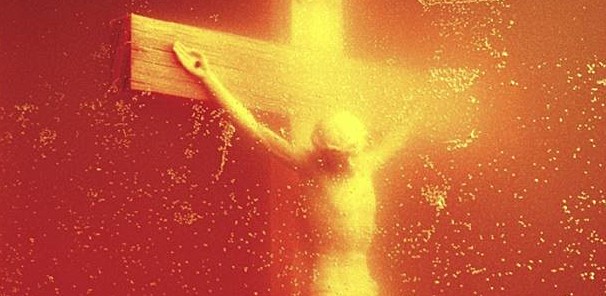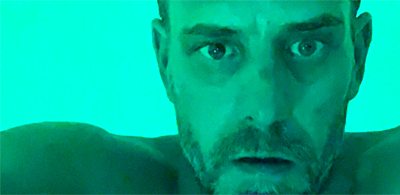The Red Pope Meets Piss Christ
In the Vatican City State on June 23, 2023, beneath Michelangelo’s High Renaissance mural in the Sistine Chapel, Pope Francis addressed some 200 invited artists and creative types. One attendee was Andres Serrano—maker of the infamous Piss Christ photograph and other sacrilegious images. I’m not writing this essay as a practicing Catholic, but as a working artist.
The Pontiff’s assembly was organized by the Vatican’s Dicastery for Culture and Education; it marked the 50th anniversary of the Modern and Contemporary Art Collection in the Vatican Museums. Those invited included architects, actors, directors, musicians, painters, photographers, poets, playwrights, sculptors, and writers from more than 30 countries. My question is, why exactly did Pope Francis invite Mr. Serrano to his gathering?
For those unaware, Serrano is an American postmodern photographer whose works focus on the transgressive; I have never been a fan of his. He is well known for his Morgue series of photographs, some three dozen Cibachrome photos showing individual human corpses in an unspecified morgue. You may or may not want to view the unsettling images.
Serrano is also celebrated for his 2007 photo series titled Shit, sixty-eight close up views of excrement dropped by dogs, bulls, jaguars and the artist. There’s a joke in there somewhere about the artist’s work being crap… but I won’t tell it.
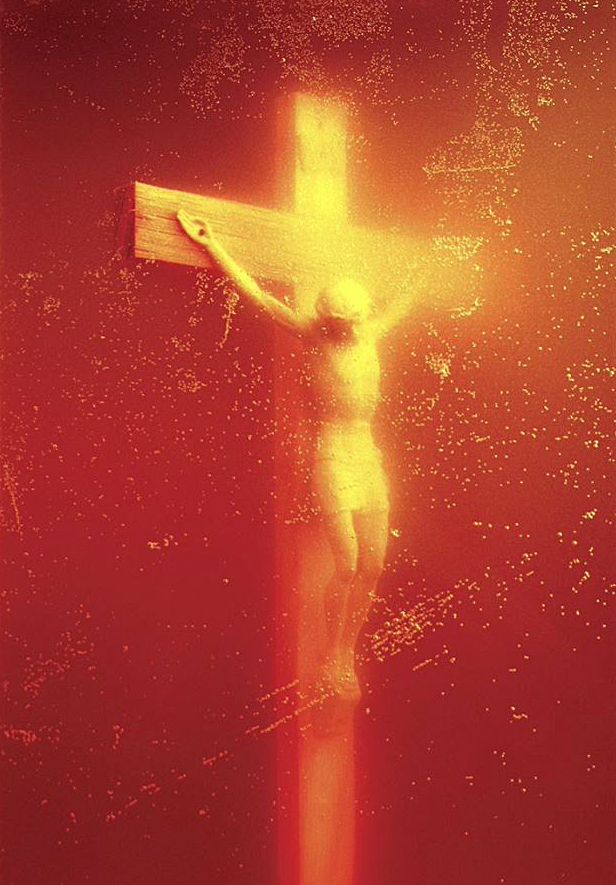
The photographer is most well known for his 1987 photo titled Piss Christ, an image of a small wood and plastic crucifix submerged in a yellow-orange-red sea of Serrano’s urine. As with many postmodern artists, Serrano has utilized human bodily fluids like blood, semen, menstrual blood, breast milk, and even feces in producing his works. And I thought working with oil paints was messy.
Piss Christ is part of the series Serrano calls “Immersions.” Those works were created between 1987 and 1990, and made use of plastic statuettes of Christ, the Virgin Mary, Moses, a statuette of Leonardo de Vinci’s Last Supper, and other icons of Christian religious devotion. All were separately immersed in glass receptacles filled with the artist’s choice of bodily fluids listed above, and then individually photographed.

If the Italian Renaissance artist Michelangelo had only known about the aesthetic wonders of bodily fluids, he might have hesitated sculpting the Pietà. It would have been so much easier to just drop a cheap crucifix into a glass container filled with piss.
Piss Christ was first exhibited in 1988 at the Southeastern Center for Contemporary Art (SECCA) in Winston-Salem, North Carolina. Outrage over the photo quickly exploded. When it was discovered the exhibit was funded by the National Endowment for the Arts (NEA), the scorn went nuclear.
Massive protests took place against the SECCA, and the NEA. In reaction, Congress cut funding to the NEA by two-fifths, and restricted grants to individual visual artists, saying the NEA had to take “into consideration general standards of decency” when awarding grants… a decision upheld by the Supreme Court in 1998.
Despite the passing of time, Piss Christ remains divisive. Over the years it has given rise to numerous protests, right up until this moment. Just inviting Serrano to attend the Pope’s address on art at the Sistine Chapel caused another uproar over the profane image.
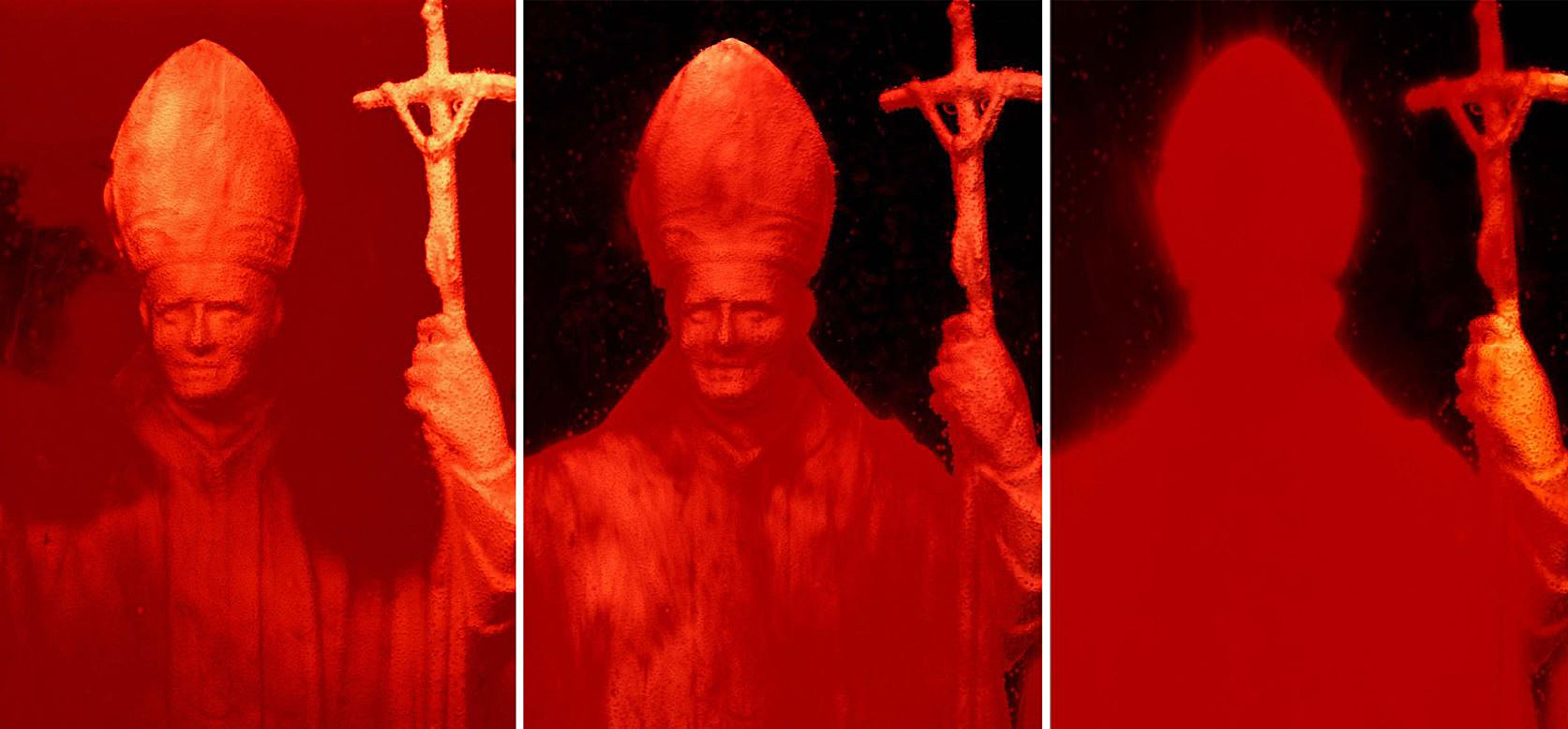
In 1990 Serrano created his Red Pope series of photos. These were created by submerging a white plastic statuette of Pope John Paul II into a receptacle of animal blood, the Pope’s robes becoming stained red. It was Serrano’s way of saying the Church is culpable in the deaths of innocents. Postmodernists call this type of art “ironic.” I’m sure you might use another word.
Nine of those invited to the Pope’s oration were from the US, including American director Abel Ferrara. He put Shia LaBeouf to work starring in Padre Pio, a bio-pic about a real-life Italian priest who received the stigmata and became venerated by the Catholic Church. I can understand Ferrara being invited, but his directorial debut was a porno flick titled 9 Lives of a Wet Pussy. Surely the pontiff was unaware of this, or maybe his invite was Christian forgiveness.
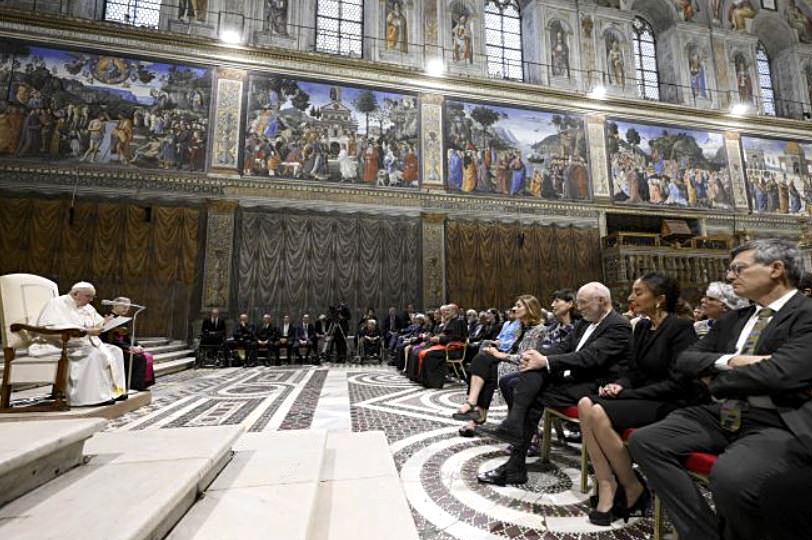
On a less sober note, I believe the oratory delivered by Pope Francis did offer some perceptive notions worth considering, though at this juncture I don’t find Francis particularly trustworthy. The Pontiff pontificated:
“The artist is a child, by this I mean no offense, who gives free rein to originality, novelty and creativity, and thus brings into the world something new and unprecedented. In doing so, artists unmask the lie that man is a ‘being towards death.’ We must certainly come to grips with our mortality, yet we are beings not towards death, but towards life.”
In describing artists, the Pope went on to say:
“Like the biblical prophets, you confront things that at times are uncomfortable; you criticize today’s false myths and new idols, its empty talk, the ploys of consumerism, the schemes of power. This is an intriguing aspect of the psychology of artists: the ability to press forward and beyond, in a tension between reality and dream.”
Bringing this essay back to Andres Serrano, he says that he was raised as a Catholic, and that he has been a Christian all his life. In the 1995 gallery brochure for a retrospective of his works held at the New Museum of Contemporary Art in NYC, he stated:
“I don’t consider myself religious, but I do consider myself spiritual, which is why I am not a heretic. I have no problem with God; my issue is with the Church, with the dogma and confusion, a perversion of the actual teaching, that seems to have failed Christianity.”
And he once said of Piss Christ:
“What it symbolizes is the way Christ died: the blood came out of him but so did the piss and the shit. Maybe if Piss Christ upsets you, it’s because it gives some sense of what the crucifixion actually was like.”
While Serrano is one oddball Christian, it should be noted that in the history of Christian art, there have been some bloodcurdling depictions of the crucifixion of Christ—the 1512 Isenheim Altarpiece painted by the German Renaissance artist Matthias Grünewald comes to mind.
The Isenheim Altarpiece is composed of multiple paintings created on wood panels. On the central front panel of the altarpiece, Grünewald painted the emaciated body of Jesus Christ hanging dead on the cross. He wears a crown of bloody thorns. Whipped before being crucified, his flesh is lacerated and torn. It’s the deathly color of Christ’s body that presents the most appalling sight, it seems to be turning green with putrefaction.

Grünewald was careful to show the five holy wounds of Jesus. Huge iron nails are driven through both his hands and feet—his fingers splayed out in agony. His side, pierced by a Roman soldier’s spear, bleeds profusely. Grünewald’s painting presents one of the most horrific visions in the history of art, yet… no one doubts the artist’s devoutness.
Think back to what Serrano said about Piss Christ; “it gives some sense of what the crucifixion actually was like.” Given how Grünewald painted such a gruesome crucifixion scene, one can almost see Serrano’s point, save for one important detail—Serrano is no Grünewald. In terms of artistry, craft, technique, and the ability to make something visionary out of something horrid, Grünewald triumphs.
Needless to say, I don’t wish to see the beliefs of Christians, Catholics, Jews, and Muslims disparaged, but how is it that Christians and their faith are constantly targeted by contemporary artists? While Serrano attacks every Christian holy figure, I can’t imagine him or his postmodern cohorts in the art world, insulting and demonizing the Prophet Muhammad. And which sane Western art critics, if there are any left… would approve of such contemptuous behavior?
A case in point would be The Holy Virgin Mary, a painting created in 1996 by the British artist Chris Ofili. The portrait contains what appears to be butterflies flying around the Virgin—they are actually photos of female buttocks and genitalia. A lump of dried elephant dung is Mother Mary’s right breast. In 2015 Christie’s sold the painting to the owner of the New York Mets for $4.6 million; it was then gifted to New York City’s Museum of Modern Art (MoMA) where it is presently displayed. The museum describes Ofili’s painting as “resplendent, majestic, and imperious yet also suffused with sexual potency.” Yeah, sure. It’s a hideously ugly monstrosity.
More recently in May of 2023, Swedish lesbian photographer Elisabeth Ohlson exhibited her photo The Last Supper at the European Parliament in Brussels. The biblical “Last Supper” occurred when Jesus gathered his twelve disciples for their last meal together before Christ was arrested and nailed to a cross.
The photo by Ohlson depicts a transexual Christ in high-heels, along with gay and trans disciples sitting at a table. The tableau looks like The Last Supper painted around 1495 by Leonardo da Vinci, except Leonardo didn’t paint trans disciples drinking champagne, with at least one of them in bondage gear. I discuss Ohlson’s photo in my essay The Last Supper of Western Civilization.
There is more than one difficult question pertaining to Pope Frances inviting Andres Serrano to the Sistine Chapel. Before he was elected Supreme Pontiff on March 13, 2013, the Pope was known as Jorge Mario Bergoglio, the Archbishop of Buenos Aires, Argentina. In 2004 Archbishop Bergoglio butted heads with one of Argentina’s leading contemporary artists.
León Ferrari (1920-2013) was a conceptual artist who delighted in browbeating the Catholic Church, the Argentine government, and Yankee Imperialism. He was proclaimed by contemporary art circles as one of Argentina’s greatest artists. An example of his “greatness” was a circa 1985 installation of live caged birds, who defecated on the statuettes of Jesus, Mary, and various Saints placed on the floor beneath the cage. Ferrari also created sculptural versions of this theme, replacing the live birds with plastic toy birdies.
Ferrari’s most well-known provocation was La Civilización Occidental y Cristiana (Western and Christian Civilization). It featured a near life-sized plastic figure of Jesus Christ crucified to the underside wings of a 6-foot plastic US fighter jet—its wings laden with bombs. The nose of the jet was pointed towards the floor, as if it was on a bombing run.

However, Ferrari’s 2004 retrospective exhibit at the Recoleta Cultural Center in Buenos Aires was the last straw for Christians. The show contained the artworks mention above, and included sacrilegious kitchen themed objects; a pink plastic toy kitchen stove where Jesus baked in the oven, the Virgin Mary boiled in a pot, and a Saint cooked in a Microwave. There was the Virgin Mary in an electric blender, and Jesus being shredded in a hand held stainless steel cheese grater. Now really, who would call such distinctive artworks blasphemous?

Thousands attended the show, as hundreds of Christians protested outside. Archbishop Bergoglio condemned the exhibit, calling for its closure on the basis that it was blasphemous. After Bergoglio’s denunciation, a judge closed the show because it “wounded the sensibilities of Christians.” So, in 2004 Bergoglio condemned Ferrari as a blasphemer, but later as Pope Francis, he invited Andres Serrano to the Vatican in 2023. Is the world not upside down?
Postmodern art has traded artistry for artificiality and craft with crassness. It places tackiness over technique, and beauty—well, there is no room for that. My critique is not so much aimed at Serrano as it is the milieu he is part of. We are drowning in a tsunami of soulless, passionless, and shockingly unskilled art.
Andres Serrano offers a cheap, postmodern minimalism; a photo of a plastic Jesus submerged in a glass of urine. This banality might seem evocative to some, but as an artwork it provides nothing more than an imitation spirituality.
And that’s really the crisis of today’s contemporary art.


